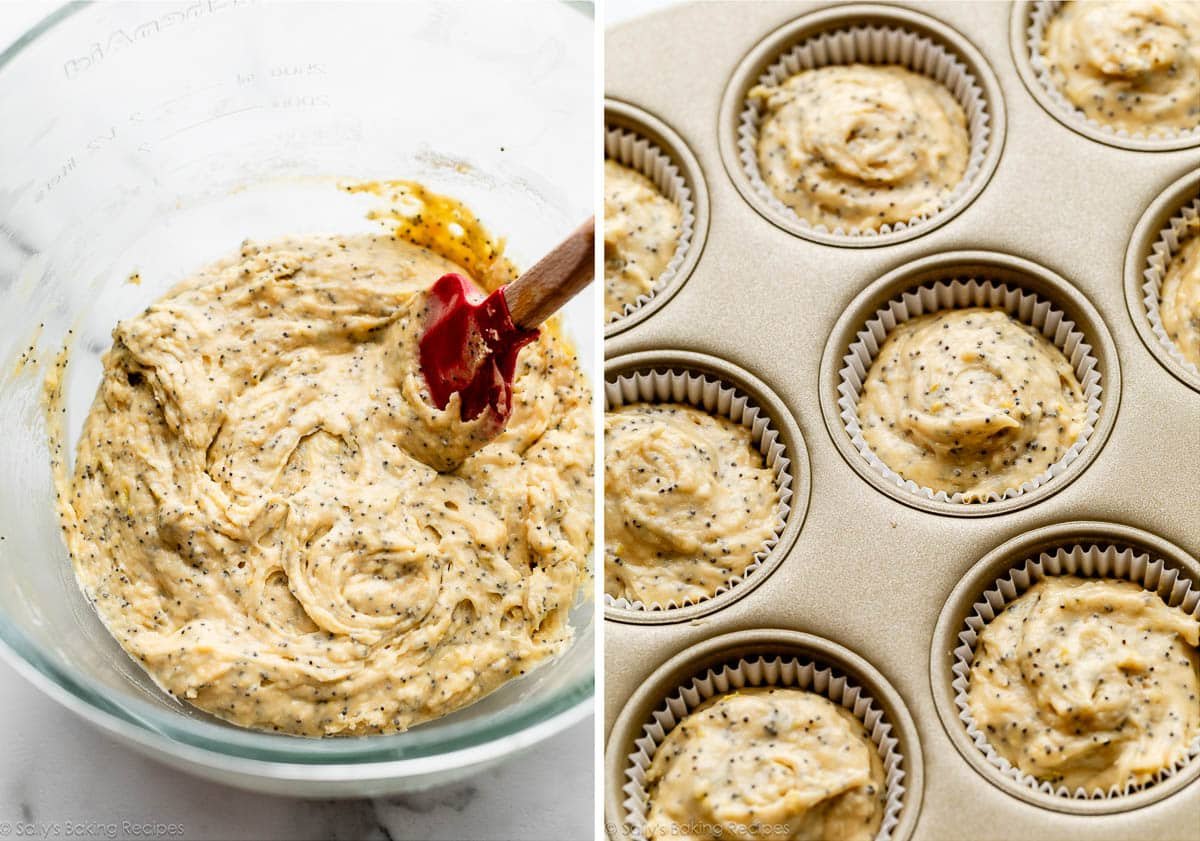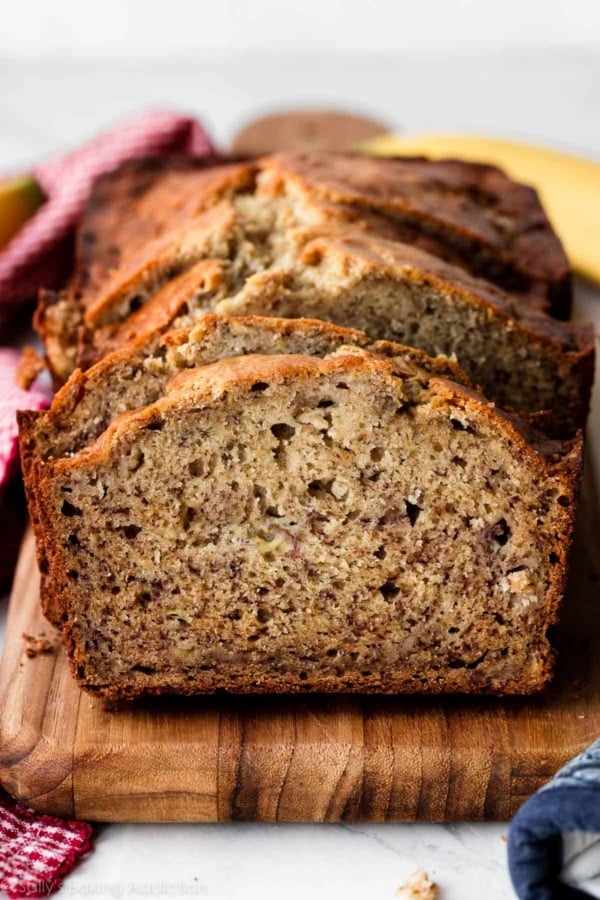Become a better baker by learning the similarities and differences between baking powder vs. baking soda. In this article and accompanying video tutorial, you’ll learn why and when to use one or the other (or both!), in easy-to-understand language—no chemistry degree required!

If you’ve ever wondered about the difference between baking powder and baking soda, and why some recipes call for one or both, you’ve come to the right place. Understanding the science behind this simple question is essential to your baking recipes turning out as expected.
Can I Substitute Baking Powder for Baking Soda (& Vice Versa)?
One of the most common baking questions I’m asked is whether you can substitute baking powder for baking soda. The simple answer is no. They’re both leaveners, whose primary function is to make baked goods rise in the oven, but they are chemically different.
If there is one thing that you take away from today’s lesson, let it be this: baking powder and baking soda are not the same, and you should not substitute one for the other in a recipe.
5 Min. Video: Baking Powder vs Baking Soda
What Are Leaveners?
Baking powder and baking soda are both chemical leavening agents. You use leavening agents—or leaveners—in baking because they help the dough or batter to rise and expand. These two white powders are both made from the chemical sodium bicarbonate, which, when combined with an acid, produces carbon dioxide (CO2). That gas is what lifts up your baked goods in the oven.
(FYI: Some examples of natural leavening agents are yeast, eggs, sourdough starter, and steam.)
What Is Baking Soda?
Let’s start with baking soda, aka bicarbonate of soda.
Baking soda is pure sodium bicarbonate, with nothing else added.
Do you remember the model volcano experiment from grade school science class, where you mix baking soda with vinegar and get an eruption of bubbles? When you mix baking soda, a BASE (pH value above 7), with vinegar, an ACID (pH value below 7), you get a chemical reaction: an eruption of bubbles. A product of this reaction is carbon dioxide.
The same reaction happens in our cookies, cakes, and muffins. When a recipe calls for baking soda, it usually calls for some type of ACID. Common acidic ingredients include buttermilk, brown sugar, yogurt, vinegar, cream of tartar, molasses, applesauce, honey, natural cocoa powder (not Dutch-process cocoa), and lemon juice.

You need this ACID in the recipe to react with the baking soda, which creates carbon dioxide and allows your baked good to rise. Like this no-yeast bread (soda bread), which gets all its lift from the chemical reaction between baking soda and buttermilk.
Baking soda also helps baked goods brown better by raising the pH level of the batter. Creating a more alkaline environment speeds up the chemical reaction that happens between sugars and amino acids in the presence of heat, which causes browning and develops flavor. In fact, it’s part of the reason we boil homemade soft pretzels in a baking soda bath before baking. Pale pretzels aren’t nearly as appetizing!
Baking soda is about 3–4 times stronger than baking powder, so you don’t need as much. More baking soda in a recipe doesn’t necessarily mean more lift. You want to use *just enough* to react with the amount of acid in the recipe. Too much baking soda and not enough acid to neutralize it will give your baked goods a metallic, soapy aftertaste.
A good rule of thumb for baking is to use around 1/4 teaspoon of baking soda per 1 cup (125g) of flour.
What Is Baking Powder?
Now let’s talk about baking powder.
Baking powder is a mix that contains baking soda, as well as a dry acid to neutralize it—typically cream of tartar—and sometimes cornstarch (a drying agent).
Because baking powder already contains an acid to neutralize its sodium bicarbonate, it is most often used when a recipe does not call for an additional acidic ingredient, like sugar cookies or scones.

However, this isn’t always the case. You can still use baking powder as the leavening agent in recipes calling for an acidic ingredient, particularly when you want the flavor of the acidic ingredient to shine through, like in a lemon pound cake.
Because it’s a mix, baking powder isn’t as strong as baking soda. A good rule of thumb is to use around 1 teaspoon of baking powder per 1 cup (125g) of flour.
What Is Double-Acting Baking Powder?
Most baking powder sold today is “double acting.” This means that the first leavening occurs when baking powder gets wet—like when you combine the dry and wet ingredients in the recipe.
The second leavening occurs when the baking powder is exposed to heat. This is why it’s usually best to bake a batter right away—because the baking powder has already been activated.
An exception to this rule is pancakes, when I recommend letting the batter sit for a few minutes before cooking. You want to give the first activation a little time to start working before you add heat, to get those bubbles going so your pancakes rise up nice and fluffy in only a few minutes on the hot griddle.

Why Do Some Recipes Call for Both Baking Soda and Baking Powder?
The simplest answer is that sometimes you need more leavening than you have acid available.
If a recipe contains an acid, like the sour cream in my vanilla cupcakes recipe, but the carbon dioxide created from the acid + baking soda is not enough to leaven the volume of batter, we need to add baking powder as well, for necessary lift.
Another example for using both is my buttermilk pancakes recipe. In this recipe, you use buttermilk partly for its tangy flavor. If we used only baking soda, it could neutralize all of the buttermilk’s acid and we’d lose that tanginess! However, by including baking powder as well (which has its own acid), some of the buttermilk’s flavor is left behind, and there is still enough leavening for fluffy pancakes.

Another reason to use both baking powder and baking soda is because in addition to causing the baked good to rise and expand, they also affect both flavor and browning.
Let Me Show You the Difference
To demonstrate the importance of using the right amount and type of leavener in your baking recipes, I made 3 batches of vanilla cupcakes.

- I made the cupcakes as written, with 3/4 teaspoon of baking powder and 1/4 teaspoon of baking soda, which is the perfect balance for this batter.
- I made the cupcakes with 1 teaspoon of baking powder. It didn’t brown enough, and it baked up short and squat because it didn’t rise enough because baking powder isn’t as strong as baking soda. The texture was gummy and dense.
- I made the cupcakes with 1 teaspoon of baking soda. You can see that it browned too much, and also sank in the middle because the baking soda is too strong and there wasn’t enough acid in the batter to neutralize it. And—you’ll have to take my word for this—it tasted AWFUL!

Follow the recipe as written with the combination of baking powder and baking soda for simply perfect vanilla cupcakes. 🙂

Make Sure They’re Fresh
No matter which leavener you’re using in your baking recipe, I recommend replacing baking powder and soda every 3 months, to make sure they’re fresh.
If you don’t bake often, you may need to test your baking powder and soda for effectiveness before using.
How to Test Baking Powder for Freshness
To test baking powder, pour 3 Tablespoons of warm water into a small bowl. Add 1/2 teaspoon of baking powder. Give it a stir. The mixture should moderately fizz if the baking powder is effective.
How to Test Baking Soda for Freshness
To test baking soda, pour 3 Tablespoons of white distilled vinegar into a small bowl. Add 1/2 teaspoon of baking soda. Give it a light stir. The mixture should rapidly bubble if the baking soda is effective.

Key Takeaways:
- Baking soda is pure sodium bicarbonate. Use baking soda when the recipe calls for an acidic ingredient.
- Baking powder contains baking soda, plus other ingredients, including a dry acid. Use baking powder when there’s no additional acidic ingredient in the recipe.
- If your recipe calls for both baking soda and baking powder, there’s a reason for that, so be sure to follow the recipe.
- Both leaveners are initially activated when combined with wet ingredients, so bake right away, unless your recipe instructs otherwise.
- Keep it fresh: Replace your leaveners 3 months after opening.
Remember that baking is science and it takes practice, trial and error, and the willingness to learn in order to succeed. If you’re interested in learning more, head on over to the Baking Tips section of my website. Here are just a few of the many helpful articles and video tutorials you will find there:



















Reader Comments and Reviews
My pound cake with 3 cups of flour calls for. 1/2 tsp of baking powder, is this right
Hi Judy, you’ll notice that our pound cake recipe uses the same ratio. Baking powder is another unconventional ingredient in pound cake. We don’t use much for this amount of batter, but the small amount lightly lifts the crumb so the cake isn’t overly heavy and squat.
I am corn intollerant and ingesting corn in any form or derivation can be life-threatening. Can corn starch be replaced with arrowroot or some other statch?
Hi Twila, it depends on the recipe, but we’ve heard many bakers report success using arrowroot powder in the place of cornstarch in baking.
I used 1 tbsp of baking Powder in your recipe as indicated, but I have a distinct aftertaste after the biscuits are baked. Should I eliminate the powder?
Hi Dan! Did you use aluminum free baking powder? What recipe did you make? Baking powder can take on a funky taste when it’s getting old as well, we would try again with fresh.
I think this is the most informative piece on baking powder/soda I have come across so far. thanks for this
I have kept my baking soda and baking powder around for years without replacing them. I did not know they expire! Thank you for telling us how to test them. I have never heard this before!
This was helpful. Want more of these baking chemistry lessons. Baking with knowledge
I’ve had so much success with your recipes, and just discovered your Baking Tips pages! I started out on your Natural vs Dutched chocolate info which led me here. Thank you for great info. When I discovered, at a very late age, that cooking was chemistry it changed so much! It made such a difference in how I see baking and cooking, and actually made it more enjoyable (and often more tasty and successful!). Thanks again for a great resource and great recipes!
We’re so happy to read that our posts have been helpful to you, Debbie. Happy baking!
Thank you so much for the explanation of baking soda v baking powder. I had always knew that one was not a suitable substitute for the other, but never got around to investigating the differences between the two. You explained it perfectly, especially the part of why at times you need to use both. Love your vlogs, it is a go-to source for new recipes!
Forget the receipes, for now. What I needed was a better understand of the differences between using baking soda and baking power. It clarified why some of my recent baking project were a disaster. I feel like I was lucky over the years since I just followed recipes and didn’t experiment. Thanks for the chemistry lesson.
So glad this was helpful, Frank!
Have you ever put baking soda in hoecakes?
My grandmother when I was little, made hoecakes in the coals of the fireplace in a covered skillet.
Was the best!
Hello! I’m curious to know why your sugar cookie recipe has 2.5 cups of flour but only 1/2 tsp of baking powder if the ration is 1 c flour to 1 tsp baking powder? Thanks!
Hi Esther, you don’t want the sugar cookies to puff up too much, or they’ll lose the cookie cutter shape. So, I use less baking powder… just enough to give a little rise.
Thank you for sharing your vast knowledge
So if a fried donut recipe has 5 cups of flour, and 1-1/2 Cups buttermilk, how much of which leavening would I use?
Hi Jenice, is there a specific donut recipe you’re referring to?
This one, but cut in half. Super fluffy, almost too big, and I was wondering if it was because of the leaving.
https://what8ate.com/recipes/doughnuts/
Hi Jenice, this isn’t our recipe and we haven’t tested it to be able to provide feedback here. If you want to give one of our doughnut recipes a try, these Homemade Glazed Doughnuts are a favorite!
My mom made chocolate cake with boiling water and baking soda
I made the bottom layer (brownie) from your chocolate mint brownies to make homemade brownies. I added 1/2 tsp cinnamon and a pinch of cayenne pepper. They were delicious! Mostly because your recipe created the best brownie texture ever! I love your recipes!
Thanks a lot for the information. It really helped and very interesting. I don’t bake so often, hence need to test my baking powder which I bought ages ago. Thank you.